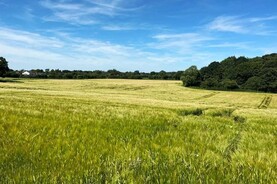The Irish Grassland Association beef event is always a great evening and the group have visited some excellent farms down through the years.
This year’s venue is no exception with Martin and Caroline Shaughnessy’s farm a perfect location for the annual event.
The farm is a typical west of Ireland sheep and suckler farm with a 16 cow suckler to weanling production system run alongside a mid-season lambing flock of 150 ewes.
The farm which extends to 68 acres (27.6ha) is situated just outside Ballinrobe in Co Mayo and is 50% owned and 50% leased ground which includes 14 acres of rough grazing.
Martin runs a herd of 16 three-quarter-bred Limousin dams mated to Belgian Blue sires each year. Maiden heifers are crossed back to Limousin genetics, while sexed semen was also introduced in 2023. Martin uses 100% artificial insemination on the farm and is aiming to breed bull weanlings for the export trade and heifers for the home market.
Lambing season
The sheep enterprise consists of Suffolk and Texel-cross ewes – split lambing at the start of February and then again around end of March each year. The ewes are synchronized to leave the management during lambing easier. Lambs are sold through the South-Mayo Lamb Producer Group.
The suckler system is quite simple – a herd of top-quality E and U-grade cows capable of calving a top-quality calf and the ability to feed that calf with lots of milk.
Martin also insists that a cow must calve every 365 days – a calving interval of 363 days was achieved in the 2023/2024 breeding/calving season.
Calving starts on 1 January annually with all cows calved by the end of March. Top-quality grass is introduced at the end of March when the pairings are turned out for the year. While this might be considered late for some, early spring grass is prioritised for the early lambing ewes.
Grazing
The cattle graze a 10-12 ac block on the home farm which is laid out in paddocks under a leader-follower system. The calves graze ahead of the cows allowing them to utilise quality grass swards before the cows.
This also allows Martin to introduce meal prior to weaning. In 2023, average 200-day weights stood at 315kg for the males, while the females weighed 271kg at that stage.
In terms of grass growth Martin generally aims for an application of protected urea in early spring as soon as ground conditions allow.
First cut silage is targeted for an early June cut with any paddocks that have gone too strong for grazing also coming in along with the first cut silage.
Second-cut silage generally takes place in July. The farm grew 10.6 t DM/ha in 2023 – well above the national average grown on Irish drystock farms. Slurry is also spread in spring at a rate of 3,000 gals/ac for both silage crops.
Most of the machinery work is contracted out – allowing Martin to focus on other important tasks around the farm.
With his relatively small herd of cows, Martin is operating at the higher end of the market for both males and females. In 2023, his average price for both males and females stood at €1,700/head – an impressive price for weanlings weighing between 300-400kg.
This free event takes place on Tuesday 11 June and is sponsored by FBD Insurance. There will be some light food and refreshments available from 6pm and the event will get underway at 6.30pm sharp and finish at 8.30pm.






 This is a subscriber-only article
This is a subscriber-only article










SHARING OPTIONS: